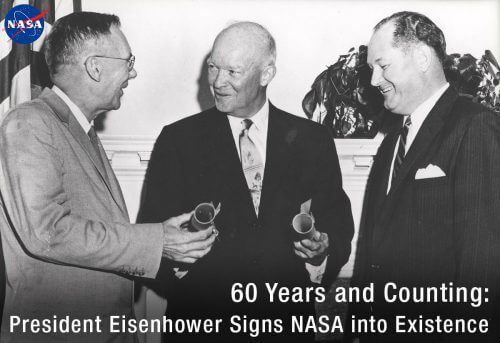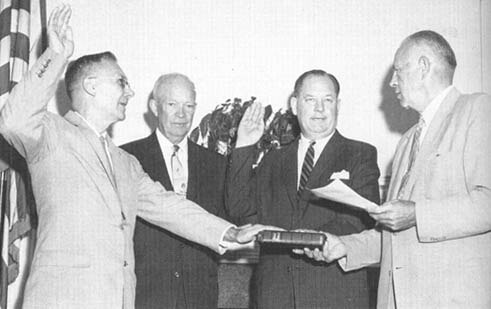The agency, which was hastily established from the merger of several bodies and research laboratories in August 1958, was designed to respond to competition from the Soviet Union after the launch of the first Sputnik satellites. However, even though its first vocation was military-political already upon its establishment it was tasked with expanding the knowledge of man and establishing long-term studies
Translation: Avi Blizovsky and Nahum Sherashevsky

Although NASA is best known for sixty years of engineering and scientific achievements, it was originally created as a matter of national security. After the Soviets flew the first two Sputniks in 1957 and Sputnik 3 in 1958, the US government saw space as an important new political, even military, battlefield and began planning a long-range space program.
“It was like a bomb dropped on Capitol Hill,” congressional staffer Eileen Galloway said in a 2000 interview, “because we were so surprised that the Soviet Union was first. Both countries, the United States and the Soviet Union, had space projects in the International Geophysical Year, but our project was very small. It was a satellite that weighed a little less than a kilo and a half, and the Soviet satellite [weighing almost 85 kg] really opened up outer space as the new environment, in addition to land, sea and air." Scientists urged President Eisenhower to establish a new agency that would be tasked with overseeing space exploration as a civilian agency, fearing that military oversight would mean research only in the areas of military priority.
The debates in Congress on the subject, when the chairman was Senate Majority Leader Lyndon B. Johnson (Democrat, Texas) began in November 1957 and lasted six weeks. Johnson asked Galloway, a security analyst at the Congressional Research and Information Service, to summarize the testimony in Congress. Her report, titled "Congress's Problems in Forming Outer Space Legislation," recommended several options including the creation of a new civilian agency to lead America's space activities.
On April 2, 1958, President Dwight D. Eisenhower sent Congress a bill to establish a civilian National Aeronautics and Space Agency, based on the existing National Advisory Committee for Aeronautics (NACA), to oversee the US space program. Twelve days later both houses, the Senate and the House of Representatives, introduced versions of bills to establish such an organization, and debates began the next day. Galway successfully lobbied to call the new organization an administration rather than an agency to give it broader authority to coordinate with many other government agencies.
The House bill passed on June 2 and the Senate version on June 16. Senator Johnson chaired a bipartisan team to create a unified version of the law, and will meet with the president after the July 4 (Independence Day) holiday to resolve the remaining issues. Congress passed the final version of the law, the National Aeronautics and Space Act, on July 16, and President Eisenhower signed it on July 29, 1958. The law established eight goals for the National Aeronautics and Space Administration (NASA):
- Expanding man's knowledge of phenomena in the atmosphere and in space.
- Improving the usability, performance, speed, safety and efficiency of an aeronautics and space vehicle.
- Development and operation of a vehicle capable of carrying devices, equipment, supplies and living creatures in space.
- Establishing long-term studies on the potential benefit to be derived from the utilization of aeronautics and space activities for peace and science purposes, their opportunities and the problems associated with them.
- Maintaining the role of the United States as a leader in aeronautics and space science and technology and in their application to peaceful activities in and out of the atmosphere.
- Making available to agencies directly concerned with national defense discoveries that have military value or significance, and providing by those agencies to the civilian agency established to direct and supervise non-military aeronautics and space activities, of information about discoveries that have value or significance to that agency.
- Cooperation of the United States with other States and groups of States in the work done under this Act and in the peaceful application of its results.
- The most effective utilization of United States scientific and engineering resources, through close cooperation among all interested United States agencies to avoid unnecessary duplication of activity, means, and equipment.
Although the law has changed over the years, these eight goals still describe the primary roles of NASA today.

On August 8, President Eisenhower appointed T. Keith Glennan, president of the Case Institute of Technology in Cleveland, Ohio, to the NASA administrator and Heu L. Dryden, NACA Director, to Deputy Director. The Senate confirmed the nominations a week later and they were sworn in at the White House on August 19. NASA officially began operations on October 1, 1958, with its first headquarters temporarily located at the Dolley Madison House in Washington, DC.
To the article on the NASA website
More of the topic in Hayadan:
- Fifty years in space - then and now (NASA remarks by NASA chief Michael Griffin in 2007)
- Access to space - the next generation of the highway
- The Apollo program: what would have happened if?

One response
Congratulations
I wonder when he will build a city on Mars